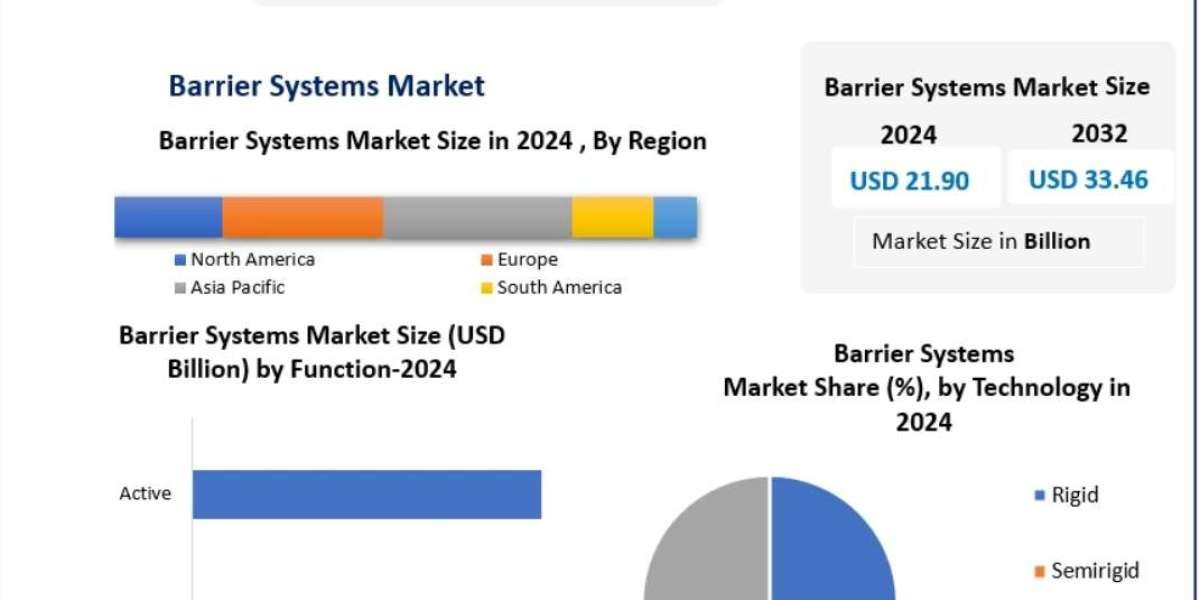Global Barrier Systems Market Overview (2025–2032)
The Global Barrier Systems Market, valued at USD 21.90 billion in 2024, is projected to grow at a CAGR of 5.44% from 2025 to 2032, reaching approximately USD 33.46 billion. Barrier systems—including crash barriers, fences, bollards, drop arms, and specialty devices—are essential in safeguarding motorists, pedestrians, and critical infrastructure from accidents and security threats. With urbanization accelerating worldwide, governments and transportation authorities are increasingly enforcing stringent safety regulations, boosting the demand for advanced protective solutions across highways, airports, urban transit networks, and industrial facilities.
To know the most attractive segments, click here for a free sample of the report:https://www.maximizemarketresearch.com/request-sample/26496/
Market Dynamics
Drivers:
The growth of the Barrier Systems Market is largely fueled by infrastructure modernization and stringent safety regulations. Governments are investing heavily in highways, smart cities, transit networks, and airport infrastructure, creating demand for crash cushions, guardrails, and energy-absorbent end treatments. Rising vehicle ownership, road congestion, and traffic-related fatalities have intensified the enforcement of global safety standards, such as MASH in the U.S. and EN 1317 in Europe. In Asia-Pacific, programs like India’s Bharatmala Pariyojana and Smart Cities Mission have further propelled the deployment of safety barriers.
Challenges:
Despite rising demand, high installation and maintenance costs—especially for steel, aluminum, and composite barriers—pose a significant barrier. Urban projects often require complex adjustments for underground utilities, increasing project timelines and costs. Recurring maintenance expenses for inspections, repairs, and replacements also hamper adoption, particularly in developing regions.
Market Segmentation
By Type:
Crash Barrier Systems: Includes crash cushions, end treatments, sand and water-filled barriers, guardrail energy-absorbent terminals, and others. This segment dominated the market in 2024, driven by safety compliance and growing infrastructure projects.
Crash Barrier Devices: Encompasses fences, bollards, drop arms, and other devices, commonly deployed for both security and traffic management.
By Material:
Metal: Steel, aluminum, tungsten, and other alloys dominate due to durability, strength, and cost-effectiveness. Steel remains the most preferred material for highways, airports, and industrial facilities.
Non-Metal: Plastics, wood, and concrete are increasingly used for flexible or temporary installations.
By Function: Active and Passive barrier systems.
By Technology: Rigid, Semirigid, and Flexible systems.
By Access Control Devices: Biometric systems, card-based access, remote-controlled barriers, turnstiles, and more.
By Application: Roads/highways, railways, airports, factories, data centers, retail, and commercial buildings.
To know the most attractive segments, click here for a free sample of the report:https://www.maximizemarketresearch.com/request-sample/26496/
Regional Insights
Asia-Pacific: Leading the market due to large-scale urbanization, infrastructure expansion, and smart city initiatives. China dominates with extensive expressway projects and smart transport networks, while India is emerging as a high-growth market. Japan, South Korea, and Australia focus on technologically advanced, IoT-enabled systems.
North America & Europe: Growth is driven by retrofitting outdated infrastructure, sustainability mandates, and sensor-enabled barrier systems to enhance operational efficiency.
Middle East & Africa: Growth is concentrated in high-security applications and expanding urban transport networks.
Technological Trends
Intelligent & Sensor-Enabled Barriers: Integration with IoT and AI allows real-time monitoring, predictive alerts, and automated traffic management.
Sustainable & Modular Materials: Recycled composites, corrosion-resistant alloys, and eco-friendly coatings are replacing traditional materials to meet green building standards. Modular designs facilitate rapid installation and maintenance.
Traffic & Mobility Integration: Barriers are becoming active components of Intelligent Transport Systems (ITS), coordinating with adaptive signals and automated tolling for optimized traffic flow.
Competitive Landscape
The Barrier Systems Market features a mix of global and regional players:
North America: Lindsay Corporation, Valmont Industries, Hill & Smith, Trinity Industries, Delta Scientific, A-SAFE, Rite-Hite, Tractel Ltd, Barrier1, Betafence.
Europe: Bekaert SA, Hill & Smith, Betafence, A-SAFE, Avon Barrier Corporation, FutureNet Group, Tractel Ltd, Arbus Ltd, Delta BLOC International, Nucor Corporation.
Asia-Pacific: Tata Steel, Bekaert SA, Valmont Industries, Lindsay Corporation, Avon Barrier, Guangxi Shiteng, Arbus Ltd, Barrier1, A-SAFE, FutureNet Group.
Key strategies include mergers, acquisitions, government partnerships, and investment in IoT and AI-enabled solutions. Notable product developments include Delta Scientific’s DSC550 open-frame vehicle barrier and Lindsay Corporation’s TAU-XR Xpress Repair Crash Cushion, both emphasizing rapid deployment, durability, and high safety standards.
Conclusion
The Barrier Systems Market is evolving into a high-tech, sustainable, and safety-focused industry. With rising infrastructure investments, urbanization, and regulatory compliance, the market is set for steady growth. The adoption of intelligent, modular, and eco-friendly barriers is reshaping urban, industrial, and transport safety ecosystems worldwide.



